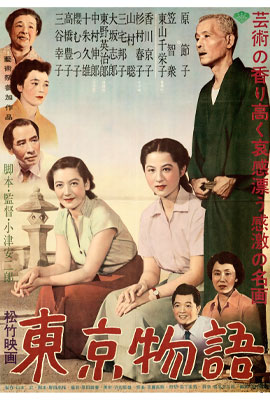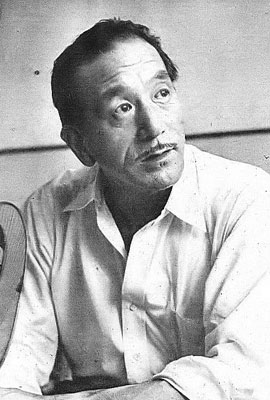
(1953)
directed by Yasujiro Ozu
In “Tokyo Story,” Ozu tells a simple story. An old couple travels to Tokyo to visit their children and grandchildren. The children are busy and the grandparents’ visit upsets the family’s routines. The visit doesn’t go well. The grandparents return home. A few days later, the grandmother dies.
Now, it is the children’s turn to travel in order to console their father and honor their mother. Once again, things do not go well. “Tokyo Story” is filled with moments of quiet observation and philosophical reflection on the ways families grow apart. It shows the fears, misunderstandings, and petty grievances that often prevent members of a family from expressing their love for one another.
Ozu’s visual style is simple and elegant. His camera is set at the eye level of a Japanese person seated on a tatami mat. Every shot is carefully framed. Ozu separates the scenes in the film with evocative images from everyday life. He films trains, rising smoke, empty streets, clothes hanging on a line, and banners blowing in the wind. The passing trains suggest an outside world which is distant, isolating, and rapidly leaving the older generation behind.
The children are just too busy to spend time with their parents. They come up with a solution. They will send their parents on a vacation to Atami Hot Springs. The parents came to Tokyo to see their children, not to visit the hot springs. While the grandparents are staying at the guest house at the hot springs, there is a poignant shot of two pairs of shoes side by side outside their door. The next morning, the old couple sit side by side on a sea wall. The grandfather says, “Let’s go home!”
On their way home from the hot springs, the grandparents return to Tokyo. A middle son was killed in World War II. Their daughter-in-law Noriko has never remarried and is an office worker living in Tokyo. Noriko treats the grandparents with great kindness and tact. On their last night in Tokyo, the grandmother decides to spend the night with Noriko and the grandfather goes out drinking with friends. The grandmother and Noriko have a long and loving conversation. The grandmother tells her son’s widow that she wants her to remarry.
Ozu is a teacher who makes his points subtly. We learn that it is not that we don’t have enough time to express our feelings. Rather, it is that we have arranged our lives to protect us from having to express our feelings. We distract ourselves with work and we harbor petty grievances instead of expressing our love for one another. “Tokyo Story” tells its story so well that I am always in tears by the end of the movie. When asked my opinion regarding what movie I would select as the greatest movie of all time, I always answer, without the slightest hesitation, “Tokyo Story!”
Yasujiro Ozu

Yasujiro Ozu, the director of “Tokyo Story,” examines the the circle of birth and death, the transition from childhood to adulthood, the difficulties we all face, and the tensions between generations. His films represent a profound study of the Japanese family. The titles of his films often refer to the changing of the seasons. The references to the changing seasons subtly reflect the different stages of life.
In their simplicity and poignancy, the films of the Japanese director Yasujiro Ozu speak to all of us. His films focus on the impermanence of life, the beauty of nature, and the sorrow of death. Ozu’s unique sensibility is based on the Japanese concept of “mono no aware.” The concept of “mono no aware” touches on all aspects of life. It is a pure emotional response to the impermanence of life, the beauty of nature, and the sorrow of death.
The scholar Motoori Norinaga (1730–1801) invented the concept of “mono no aware” to define the essence of Japanese culture. The phrase derives from “aware” which means “a sensitivity to things.” He believed that the singular characteristic of Japanese culture was to relate to the natural world personally without resorting to language. This enabled the Japanese to understand the world by identifying themselves directly with that world.
Yasujiro Ozu created a unique visual language. He used precise compositions, low camera angles, and deliberate pacing to create a sense of poetry in everyday life. His films renounce all the usual film conventions. During conversations, Ozu’s characters often seem to be looking away from one another. Often, they sit side by side while they talk, both looking into the distance. This is a Japanese characteristic, since looking directly into another person’s eyes is considered impolite in Japanese culture. Ozu also uses the traditional architecture of Japanese houses, including screens, sliding doors, balconies, and corridors to frame his compositions.
Ozu has other subtle techniques that give his films a unique feel. Often, he will begin a shot before the characters enter the frame or hold it after they leave the frame. This gives us a sense of the silence that fills the space when the characters are not present. You may have experienced this silence in your own life. If one returns to an empty house, for example, unlocks the front door, and enters the house, there is a brief moment when we experience a feeling of silence. Then, our presence asserts itself and the empty house becomes an occupied house. In Ozu’s masterpiece, “Tokyo Story,” an elderly couple from the country visit their busy children in Tokyo. When they exit a room, the camera repeatedly stays behind for a moment as if to say they will never return. The effect is heartbreaking.
In Ozu’s films, the action is punctuated by shots of the outside world. We see passing trains, rising smoke, empty streets, banners blowing in the wind, and clouds. These shots pause and subtly comment on the action in the film. Ozu called these “pillow shots.” In Japanese poetry, the “pillow words” serve to pause and comment on a poem.
These visual devices make an Ozu film feel very different from other films. Ozu said, “I formulated my own directing style in my own head, proceeding without any unnecessary imitation of others. For me there was no such thing as a teacher. I have relied on my own understanding.” In his video essay, “The Depths of Simplicity,” Lewis Bond says, “His style managed to walk a line so narrow that it can’t be taught. The best way to understand it is to feel it.”